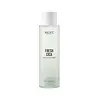What's inside
What's inside
 Key Ingredients
Key Ingredients

 Benefits
Benefits

 Concerns
Concerns

No concerns
 Ingredients Side-by-side
Ingredients Side-by-side

Calendula Officinalis Flower Water
MaskingButylene Glycol
HumectantGlycerin
Humectant1,2-Hexanediol
Skin ConditioningNiacinamide
SmoothingBetaine
HumectantWater
Skin ConditioningC12-14 Pareth-12
EmulsifyingAllantoin
Skin ConditioningEthylhexylglycerin
Skin ConditioningXanthan Gum
EmulsifyingAdenosine
Skin ConditioningCalendula Officinalis Flower Extract
MaskingCitrus Aurantium Bergamia Fruit Oil
MaskingDisodium EDTA
Coptis Japonica Root Extract
Skin ConditioningCalendula Officinalis Extract
Skin ConditioningTheobroma Cacao Extract
Skin ConditioningDipropylene Glycol
HumectantDextrin
AbsorbentSodium Palmitoyl Proline
Skin ConditioningAvena Sativa Kernel Extract
AbrasiveNymphaea Alba Flower Extract
Skin ConditioningCalendula Officinalis Flower Water, Butylene Glycol, Glycerin, 1,2-Hexanediol, Niacinamide, Betaine, Water, C12-14 Pareth-12, Allantoin, Ethylhexylglycerin, Xanthan Gum, Adenosine, Calendula Officinalis Flower Extract, Citrus Aurantium Bergamia Fruit Oil, Disodium EDTA, Coptis Japonica Root Extract, Calendula Officinalis Extract, Theobroma Cacao Extract, Dipropylene Glycol, Dextrin, Sodium Palmitoyl Proline, Avena Sativa Kernel Extract, Nymphaea Alba Flower Extract
Water
Skin ConditioningChamaecyparis Obtusa Water
MaskingPropanediol
SolventPolymethyl Methacrylate
Glycerin
Humectant1,2-Hexanediol
Skin ConditioningButylene Glycol
HumectantGlycereth-26
HumectantAsiaticoside
AntioxidantAsiatic Acid
Skin ConditioningMadecassic Acid
Skin ConditioningCentella Asiatica Extract
CleansingMadecassoside
AntioxidantAlcohol
AntimicrobialPolysorbate 20
EmulsifyingCeramide NP
Skin ConditioningPanthenol
Skin ConditioningAllantoin
Skin ConditioningSilica
AbrasivePEG-60 Hydrogenated Castor Oil
EmulsifyingSodium Citrate
BufferingTetrasodium Pyrophosphate
BufferingCitric Acid
BufferingCitrus Aurantium Bergamia Fruit Oil
MaskingCitrus Aurantium Dulcis Peel Oil
MaskingRosmarinus Officinalis Leaf Oil
MaskingLavandula Angustifolia Oil
MaskingPelargonium Graveolens Flower Oil
MaskingAmyris Balsamifera Bark Oil
MaskingCitrus Paradisi Peel Oil
MaskingMelaleuca Alternifolia Leaf Oil
AntioxidantEucalyptus Globulus Leaf Oil
PerfumingJuniperus Mexicana Oil
MaskingBoswellia Carterii Oil
MaskingAniba Rosaeodora Wood Oil
AstringentDisodium EDTA
Ethylhexylglycerin
Skin ConditioningWater, Chamaecyparis Obtusa Water, Propanediol, Polymethyl Methacrylate, Glycerin, 1,2-Hexanediol, Butylene Glycol, Glycereth-26, Asiaticoside, Asiatic Acid, Madecassic Acid, Centella Asiatica Extract, Madecassoside, Alcohol, Polysorbate 20, Ceramide NP, Panthenol, Allantoin, Silica, PEG-60 Hydrogenated Castor Oil, Sodium Citrate, Tetrasodium Pyrophosphate, Citric Acid, Citrus Aurantium Bergamia Fruit Oil, Citrus Aurantium Dulcis Peel Oil, Rosmarinus Officinalis Leaf Oil, Lavandula Angustifolia Oil, Pelargonium Graveolens Flower Oil, Amyris Balsamifera Bark Oil, Citrus Paradisi Peel Oil, Melaleuca Alternifolia Leaf Oil, Eucalyptus Globulus Leaf Oil, Juniperus Mexicana Oil, Boswellia Carterii Oil, Aniba Rosaeodora Wood Oil, Disodium EDTA, Ethylhexylglycerin
Ingredients Explained
These ingredients are found in both products.
Ingredients higher up in an ingredient list are typically present in a larger amount.
1,2-Hexanediol is a synthetic liquid and another multi-functional powerhouse.
It is a:
- Humectant, drawing moisture into the skin
- Emollient, helping to soften skin
- Solvent, dispersing and stabilizing formulas
- Preservative booster, enhancing the antimicrobial activity of other preservatives
Allantoin is a soothing ingredient known for its protective and moisturizingg properties. Because of this, it is often added to products with strong active ingredients.
Studies show higher concentrations of this ingredient can promote wound healing.
Though it can be derived from the comfrey plant, allantoin is produced synthetically for cosmetic products to ensure purity.
Learn more about AllantoinButylene Glycol (or BG) is used within cosmetic products for a few different reasons:
Overall, Butylene Glycol is a safe and well-rounded ingredient that works well with other ingredients.
Though this ingredient works well with most skin types, some people with sensitive skin may experience a reaction such as allergic rashes, closed comedones, or itchiness.
Learn more about Butylene GlycolCitrus Aurantium Bergamia Fruit Oil is the oil from the bergamot orange. It is native to Italy.
This ingredient is used to add fragrance to products. It contains limonene, linalool, and linalyl acetate.
The term 'fragrance' is not regulated in many countries. In many cases, it is up to the brand to define this term. For instance, many brands choose to label themselves as "fragrance-free" because they are not using synthetic fragrances. However, their products may still contain ingredients such as essential oils that are considered a fragrance.
When used topically, Citrus Aurantium Bergamia Fruit Oil is a photosensitizer due to its furanocoumarins. Photosensitizers make the skin and eyes much more sensitive to sunlight. Photosensitizers are linked to skin cancer.
However, more cosmetics using Citrus Aurantium Bergamia Fruit Oil are removing the furanocoumarins.
Bergamot oil was also found to have anti-inflammatory, antibacterial and antifungal properties.
Learn more about Citrus Aurantium Bergamia Fruit OilDisodium EDTA plays a role in making products more stable by aiding other preservatives.
It is a chelating agent, meaning it neutralizes metal ions that may be found in a product.
Disodium EDTA is a salt of edetic acid and is found to be safe in cosmetic ingredients.
Learn more about Disodium EDTAEthylhexylglycerin (we can't pronounce this either) is commonly used as a preservative and skin softener. It is derived from glyceryl.
You might see Ethylhexylglycerin often paired with other preservatives such as phenoxyethanol. Ethylhexylglycerin has been found to increase the effectiveness of these other preservatives.
Glycerin is already naturally found in your skin. It helps moisturize and protect your skin.
A study from 2016 found glycerin to be more effective as a humectant than AHAs and hyaluronic acid.
As a humectant, it helps the skin stay hydrated by pulling moisture to your skin. The low molecular weight of glycerin allows it to pull moisture into the deeper layers of your skin.
Hydrated skin improves your skin barrier; Your skin barrier helps protect against irritants and bacteria.
Glycerin has also been found to have antimicrobial and antiviral properties. Due to these properties, glycerin is often used in wound and burn treatments.
In cosmetics, glycerin is usually derived from plants such as soybean or palm. However, it can also be sourced from animals, such as tallow or animal fat.
This ingredient is organic, colorless, odorless, and non-toxic.
Glycerin is the name for this ingredient in American English. British English uses Glycerol/Glycerine.
Learn more about GlycerinWater. It's the most common cosmetic ingredient of all. You'll usually see it at the top of ingredient lists, meaning that it makes up the largest part of the product.
So why is it so popular? Water most often acts as a solvent - this means that it helps dissolve other ingredients into the formulation.
You'll also recognize water as that liquid we all need to stay alive. If you see this, drink a glass of water. Stay hydrated!
Learn more about Water